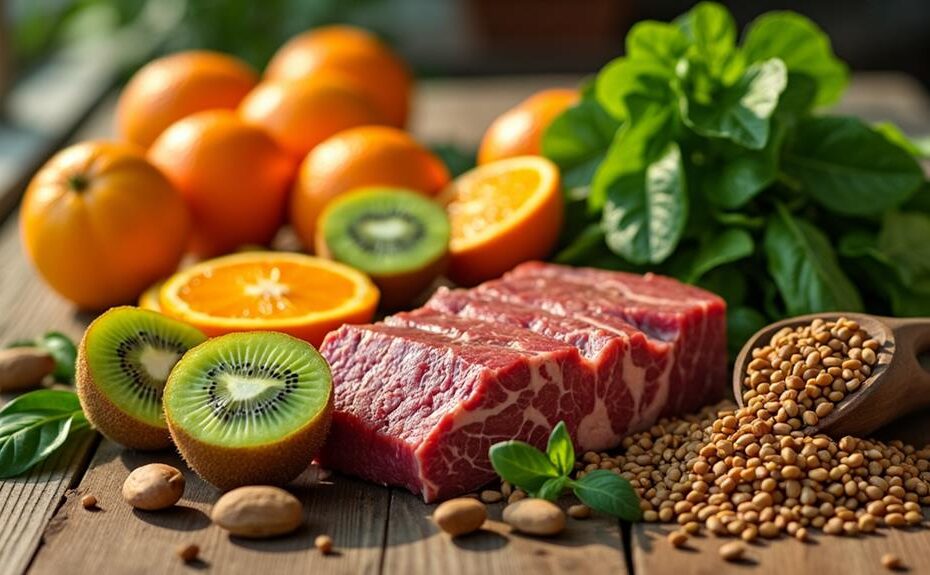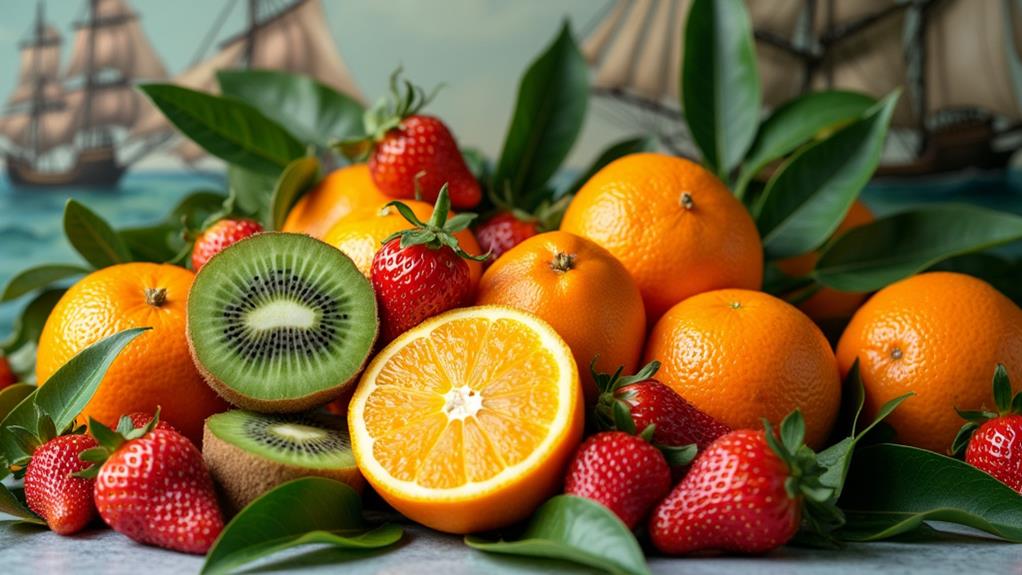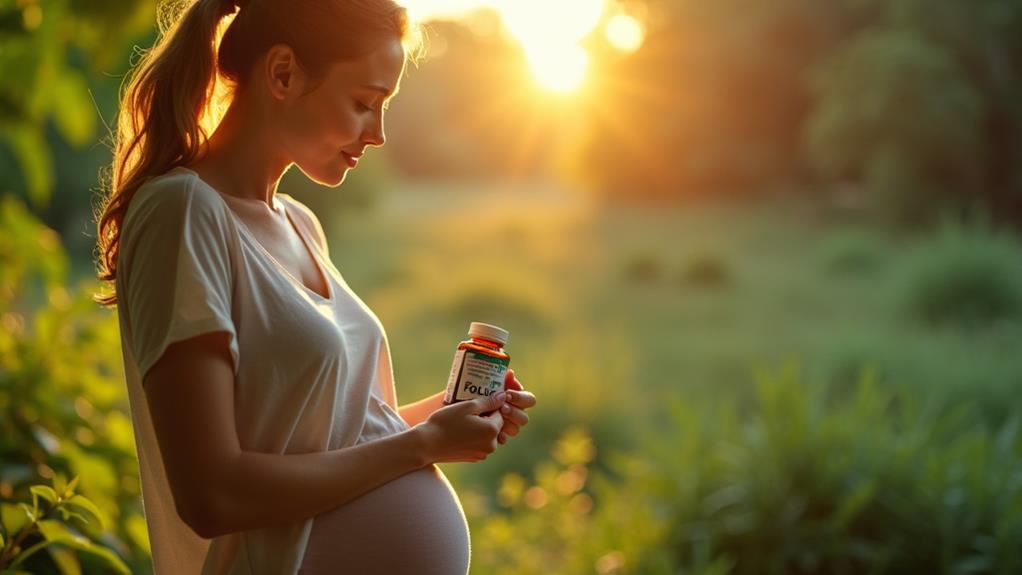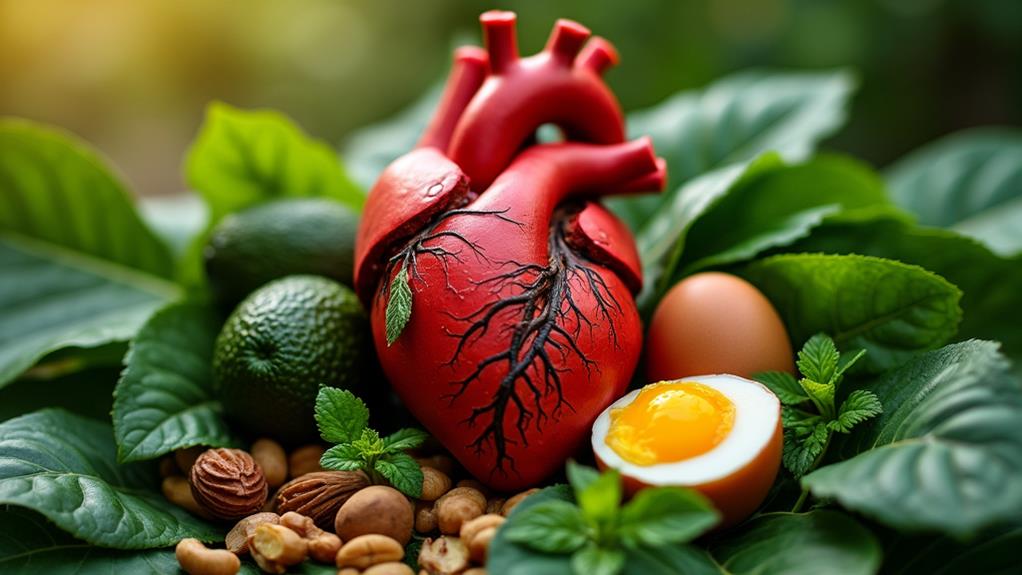







Vitamin C greatly boosts your ability to absorb non-heme iron, which is primarily found in plant sources. When you consume vitamin C alongside non-heme iron, it forms soluble chelates that enhance iron's bioavailability, potentially doubling absorption rates. This is especially essential for those relying on plant-based diets, as inhibitors like tannins and phytates can reduce absorption. By strategically pairing vitamin C-rich foods, like citrus and bell peppers, with iron sources, you maximize your nutrient intake. Want to explore how to best incorporate these foods into your meals for ideal health?
Key Takeaways
- Vitamin C enhances non-heme iron absorption by forming soluble chelate complexes with ferric iron, increasing its bioavailability.
- It counteracts absorption inhibitors like tannins and phytates, making iron from plant sources more accessible.
- Consuming 25-100 mg of vitamin C with non-heme iron can double absorption rates, significantly benefiting those on plant-based diets.
- The effectiveness of vitamin C in boosting iron absorption is dose-dependent; higher vitamin C intake yields better results.
- Regular intake of vitamin C, around 75-90 mg daily, is recommended to prevent iron deficiency anemia, especially for vegetarians and vegans.
Iron Absorption Mechanisms
Understanding iron absorption mechanisms is fundamental for enhancing your nutrition, especially if you're relying on plant-based sources for your iron intake. Iron comes from two primary sources: heme iron from animal products and non-heme iron from plants. While heme iron is absorbed efficiently, non-heme iron requires additional support for maximum absorption.
Vitamin C plays a key role here. It enhances the absorption of non-heme iron by forming a chelate with ferric iron, which maintains its solubility and counters inhibitors like tannins and phytates found in various dietary components. The effectiveness of vitamin C, or ascorbic acid, is proportional to its quantity in your meals, making it essential for improving iron bioavailability.
When you include vitamin C-rich foods alongside your non-heme iron sources, you can greatly boost your iron absorption. Meal composition matters; for instance, having iron-rich foods like lentils or spinach with a citrus fruit can enhance your iron intake. Conversely, inhibitors such as calcium can hamper this process, making it important to evaluate all dietary components when planning meals. By understanding these absorption mechanisms, you can better manage your iron status and support your overall health.
Role of Ascorbic Acid
Boosting your iron absorption can be greatly enhanced by incorporating ascorbic acid, commonly known as vitamin C, into your diet. This powerful nutrient markedly improves the absorption of non-heme iron, which is typically found in plant-based foods. In fact, many sources of vitamin C include citrus fruits and leafy greens, making it easy to include in your meals. By forming a soluble chelate complex with ferric iron, ascorbic acid increases its bioavailability in your intestines, making it easier for your body to utilize.
What's more, the enhancement of iron absorption by vitamin C is dose-dependent; the more you consume, the greater the improvement in iron uptake. Ascorbic acid also plays an essential role in counteracting absorption inhibitors, such as tannins in tea and phytates in grains, which can hinder dietary iron absorption.
Research shows that the absorption of soluble inorganic iron parallels that of non-heme iron, further highlighting the significance of ascorbic acid in enhancing iron bioavailability. While it effectively promotes the absorption of non-heme iron, remember that its impact on insoluble iron compounds is minimal. Therefore, focusing on meal composition is important for maximizing your iron intake from iron-rich food.
Dietary Sources of Vitamin C
When it comes to enhancing your iron absorption, incorporating vitamin C-rich foods into your meals is a smart choice. Citrus fruits like oranges, grapefruits, and lemons are excellent options; a medium-sized orange provides around 70 mg of vitamin C, surpassing the daily recommended intake for adults. These fruits can greatly boost the bioavailability of non-heme iron found in plant-based foods such as lentils and spinach.
But citrus isn't the only source. Red and green bell peppers are particularly impressive, containing about 120 mg of vitamin C per 100 grams, making them one of the highest vegetable sources. Including these vibrant peppers in your salads or stir-fries can dramatically improve your absorption rates of iron-rich foods. Other great sources include strawberries, broccoli, kiwi, and tomatoes, which you can easily mix into your meals.
Studies suggest that consuming between 25-100 mg of vitamin C alongside non-heme iron can double absorption rates. So, don't miss out on these delicious foods; they play a crucial role in maximizing your iron intake and overall health!
Impact on Vegan and Vegetarian Diets
For those following vegan and vegetarian diets, guaranteeing adequate iron absorption can be challenging due to the reliance on non-heme iron sources, which aren't as easily absorbed by the body as heme iron from animal products. This reliance can increase the risk of iron deficiency anemia if you don't carefully plan your intake.
To combat this issue, it's essential to pair non-heme iron-rich foods, like legumes and dark leafy greens, with vitamin C-rich items such as citrus fruits and bell peppers. Studies have shown that incorporating vitamin C into your meals can enhance non-heme iron absorption by up to 67%. This significant boost makes vitamin C critical for anyone on a plant-based diet.
To maximize iron availability, aim for a daily vitamin C intake of 75-90 mg. This approach not only helps you prevent iron deficiency anemia but also guarantees you're getting the most out of the iron present in your diet. By combining these strategies, you can effectively enhance your iron absorption, maintaining your health while adhering to your vegan or vegetarian lifestyle.
Clinical Evidence and Research Findings
Clinical evidence supports the vital role of vitamin C in enhancing non-heme iron absorption, making it an important nutrient for individuals at risk of deficiency. Clinical trials have demonstrated that vitamin C forms soluble chelates with ferric iron, markedly increasing its bioavailability in your gastrointestinal tract. For example, a randomized clinical trial at Huashan Hospital found that adding vitamin C to iron supplements resulted in a mean hemoglobin change of 2.00 g/dL, compared to just 1.84 g/dL for iron alone after two weeks. Moreover, the combination of vitamin C with other immune-supporting nutrients, such as zinc, can enhance overall nutrient absorption and effectiveness, providing thorough health benefits, as seen in products like American Standard Supplements Vitamin C.
Research also indicates that vitamin C can counteract the inhibitory effects of dietary components, such as tea and calcium, on iron absorption, thereby improving your overall iron status. Curiously, the effectiveness of vitamin C in enhancing iron absorption appears to be dose-dependent, with higher quantities yielding better results. A review of dietary factors highlighted that pairing vitamin C-rich foods with non-heme iron sources is particularly important for populations at risk for deficiency, such as vegetarians. By incorporating vitamin C into your diet, you can markedly boost your iron uptake and support your overall health.
Pairing Strategies for Maximum Absorption
Maximizing iron absorption can be achieved through strategic food pairings that incorporate vitamin C. When you consume non-heme iron sources, like beans and lentils, pairing them with vitamin C-rich foods—such as citrus fruits or bell peppers—can greatly enhance the absorption of iron. Vitamin C forms soluble iron chelates, making non-heme iron as bioavailable as heme iron. Additionally, incorporating a balanced diet rich in fruits and vegetables, including those high in vitamin C, supports overall immune function and health, especially during cold and flu season importance of vitamin C for immune function.
In your meal planning, try adding lemon juice to a spinach salad or topping oatmeal with strawberries. These simple combinations can double the absorption of non-heme iron, which is particularly beneficial for those at risk of iron-deficiency anemia. To reach the recommended vitamin C intake—75 mg per day for women and 90 mg for men—focus on foods high in vitamin C like oranges, kiwis, and tomatoes.
These foods not only enhance non-heme iron absorption but also help counteract inhibitors like tannins and phytates found in plant sources. By thoughtfully incorporating vitamin C-rich foods into your meals, you can greatly improve your iron absorption and support your overall health.
Challenges in Iron Supplementation
While pairing vitamin C with non-heme iron sources can greatly boost absorption, challenges still persist in iron supplementation strategies. One major issue is the high cost of ascorbic acid, which limits its use in nutrition programs aimed at tackling nutritional deficiency anemia. This is especially concerning for vulnerable populations like pregnant women and young children, where iron deficiency anemia remains a pressing public health concern.
Moreover, stability issues during food storage can diminish the effectiveness of ascorbic acid in enhancing iron absorption. Without proper handling and storage, the ability of vitamin C to improve iron bioavailability could be compromised. There's a clear need for effective strategies to overcome these hurdles. Researchers are actively exploring cost-effective alternatives to ascorbic acid that could enhance iron absorption from non-heme sources.
Incorporating these alternatives into supplementation programs could provide a more viable solution to iron deficiency. Ultimately, addressing the challenges in iron supplementation not only helps improve individual health but also contributes to broader public health initiatives aimed at reducing the prevalence of anemia in at-risk populations.
Monitoring Iron Levels
Monitoring your iron levels is vital for preventing anemia and maintaining overall health. Regular testing helps detect iron deficiency early, which is essential for effective management. Anemia can occur when your iron stores drop alarmingly low, leading to symptoms like fatigue, weakness, and frequent headaches. To assess your iron levels accurately, keep an eye on ferritin levels; they indicate the amount of stored iron in your body and can provide insights into your iron status.
Consulting with healthcare professionals for personalized advice on iron testing is advisable, especially if you're at higher risk of deficiency. Women of reproductive age and those with dietary restrictions should consider periodic checks to guarantee adequate iron intake. Alongside monitoring, incorporating vitamin C-rich foods into your diet can enhance iron absorption, making it easier for your body to utilize the iron from healthy foods. Remember, iron deficiency is a common nutritional deficiency that can greatly impact your well-being. By staying proactive about your iron levels, you can maintain peak health and prevent the potential complications associated with low iron levels.
Broader Nutritional Context
Understanding the broader nutritional context is essential for improving your health, especially when it comes to iron absorption. Vitamin C plays a pivotal role in enhancing the absorption of non-heme iron, which is primarily found in plant foods. If you're consuming iron-rich meals that include legumes, grains, or leafy greens, pairing them with vitamin C-rich foods like citrus fruits or bell peppers can greatly boost the bioavailability of non-heme iron.
The recommended dietary allowance (RDA) for vitamin C is about 90 mg/day for adult men and 75 mg/day for women, and meeting these needs is vital for ideal iron absorption. Studies suggest that vitamin C can counteract the inhibitory effects of compounds such as tannins and phytates, commonly found in tea and certain grains, allowing for better iron uptake.
This is particularly beneficial for individuals following plant-based diets, where iron supplements may not always be sufficient. By incorporating vitamin C-rich foods into your healthy diet, you're not only enhancing iron absorption but also supporting overall nutrient efficacy. Remember, every meal is an opportunity to maximize your nutrient intake!
Conclusion
Incorporating vitamin C into your diet can really help you absorb iron more effectively. By enhancing the body's ability to convert non-heme iron into a more absorbable form, you're setting yourself up for better health. So, don't leave it to chance—pair your iron-rich foods with vitamin C sources like citrus fruits or bell peppers. This small change can go a long way in preventing deficiencies, especially for those on vegan or vegetarian diets.







